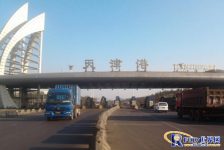
Tianjin Port Nanjiang Port Area RFID Electronic Gate Project
[ad_1]
1. Introduction to the system
The customs is the bridge and link that connects domestic and overseas increasingly, and shoulders the heavy responsibility of security and anti-smuggling inspections for the country. The daily traffic volume of vehicles at customs gates is easy to cause instantaneous blockage of gates, which brings unnecessary trouble to the management of gates. The automatic inspection and release system of customs vehicles launched by Mobaier uses radio frequency identification technology to automatically identify passing vehicles, which can effectively improve the efficiency of gate traffic and track and manage various customs vehicles.
2. System composition
System includes carRFIDAutomatic identification system, image monitoring system, monitoring computer, lane control equipment.
3. Workflow
◇ When a vehicle or a container vehicle enters the passage and is detected by the entrance induction ring, the reader will be activated. The reader will read the electronic tag on the windshield of the car within 0.5 seconds at a distance of 7-10 meters. The validity of the legal identity is checked.
◇ The off-vehicle reading and writing equipment is generally networked with the vehicle information management system, and information can be exchanged in real time through the vehicle information management system. When necessary, an order can be issued to prohibit the passage of the vehicle. The off-vehicle reading and writing equipment can also work offline without networking, read the vehicle electronic tag information, and use the blacklist stored in the machine to compare and take necessary measures.
◇ When leaving the monitoring area and the exit induction coil detects the vehicle, clear the content on the electronic vehicle display (option), close the automatic railing (option), and submit the entry and exit vehicle data to the information management system.
4. Project Overview
This project aims to promote the platformization and serviceization of vehicle-related information in public security, port traffic and other systems, with electronic license plates as the information carrier, and RFID as the basic information collection method to realize the sharing of vehicle-related information resources and improve vehicle management. Information level.The whole system is based on the IoT system architecture, which consists ofInternet of ThingsThe perception layer, the Internet of Things network layer and the Internet of Things application layer are composed of ultra-high frequency RFID products, and the information is collected from the electronic tags through the RFID reader, and the collected data is processed and integrated to build a comprehensive Tianjin port vehicle management. The information data platform realizes the full automation and electronization of vehicle management.
The implementation of this project will effectively solve the automatic identification of vehicles, realize precise management of vehicles, automation of vehicles leaving the port, traffic statistics and analysis, application services for vehicles in the port, and public security management of vehicles in the port, which will directly bring economic and political benefits to Tianjin Port.

[ad_2]



